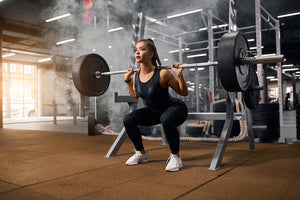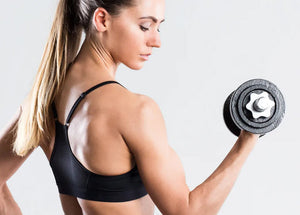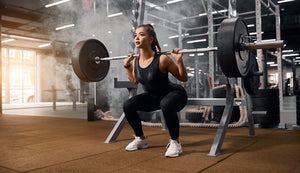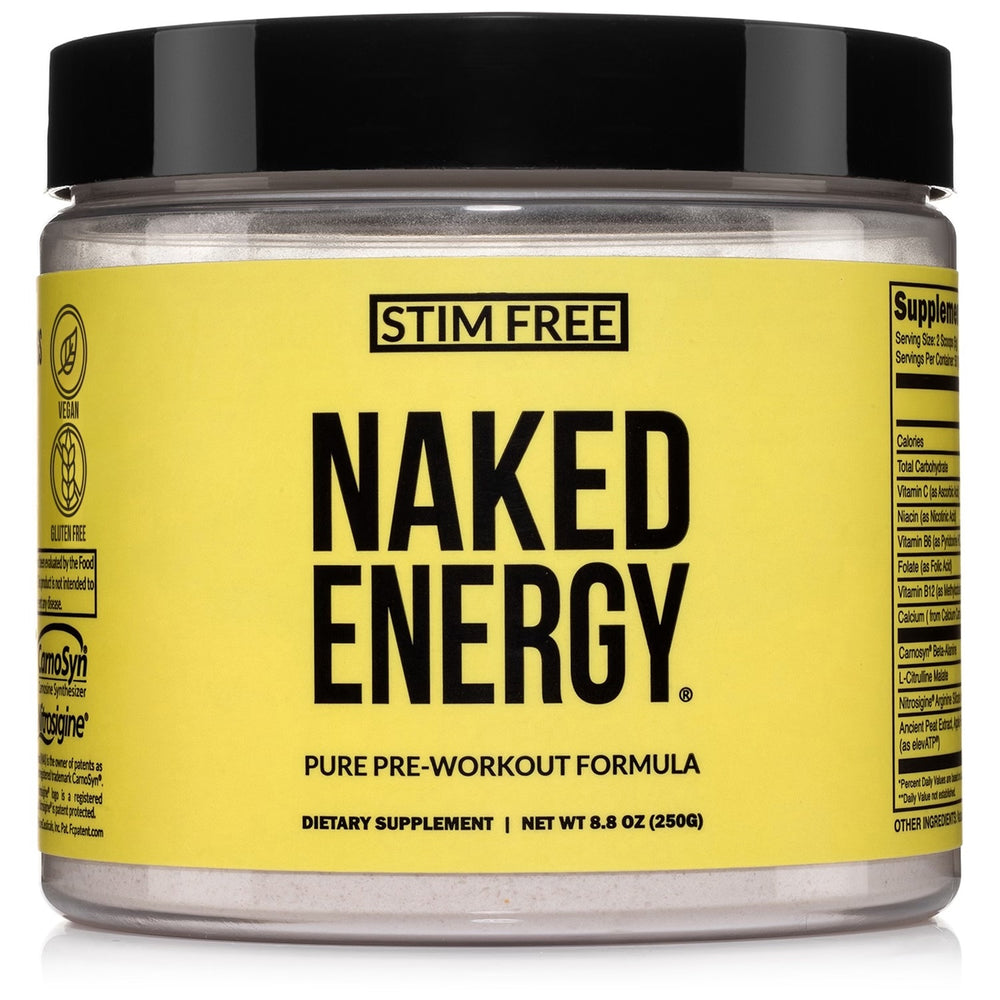Hip hinge exercises are among the most important movements you can do at the gym. If you care about building power, mobility, flexibility and functional strength, you need to be doing these every time you work out.
In this article we're going to explain everything you need to know about the hip hinge, from a detailed explanation of the movement and why it's so beneficial, to a list of the best hip hinge exercises to work into your routine.
We'll finish up with some form tips and frequently asked questions about hip hinges.
What is a Hip Hinge Exercise?
A hip hinge exercise is one where your movement centers around a hinging motion at the hips. Your hips are the fulcrum of the movement, with your legs staying upright and the upper half of your body leaning forward and closer to the ground.
The hip hinge is one of the human body's most fundamental movements. You can find a hip hinge movement in many simple, everyday activities, such as sitting down in a chair, getting up out of bed or bending over to fold laundry.
This extends to most athletic movements, such as running, jumping or climbing. In most cases, the hip hinge is responsible for most of the power you generate in the action.

Why is it Important to Learn the Hip Hinge Movement?
Learning how to do a hip hinge properly, as well as strengthening this movement, is important for improving your athletic performance, as well as strengthening and preventing injuries in surrounding areas, such as the lower back.
Getting familiar with the hip hinge will help you build a stronger foundation, which makes you more mobile and helps you maintain better posture.
Another benefit of hip hinges is how efficient they are, and how many muscle groups you can hit with just a single exercise.
Since the hip is such a central joint in the body, you'll often work the entire body from just one movement, which delivers more benefit in less time, compared to isolation exercises centered around the arms and legs.
What Muscles Do Hip Hinge Movements Work?
The primary muscles worked in hip hinge movements are those along the posterior chain, such as the glutes, hamstrings, calves, erector spinae, lats, and back side of the shoulders.
These muscles are vital for functional athleticism, full-body strength and power, and for building a strong foundation that helps you avoid injury.
Additionally, hip hinging often works the core muscles, which provide similar benefits for functional full-body strength and mobility.
7 Best Hip Hinge Exercises
The bottom line on hip hinge exercises is simple: they're as fundamental a movement as the push and pull, and you should incorporate them into your workout routine.
Now let's help you apply that, as well as help you understand the hip hinge better, with some of the best hip hinge exercises out there.
Deadlift

The deadlift is probably the most fundamental hip hinge exercise. It's built around the hip hinge, which is the movement when you lift up from the bent over starting position to the upright, standing position in a deadlift.
The muscles worked in a deadlift are pretty much the same as what we described in the last section, and deadlifts are great at building strength along the posterior chain.
Thinking of a deadlift as a hip hinge movement is a great idea, as it helps you maintain correct form, which is vital when you're doing deadlifts.
Next time you do a deadlift, think of the hips as the center of the movement, keeping everything else stable and using a basic hip hinge movement to generate power for the lift.
This goes for pretty much all deadlift variations, from standard barbell deadlifts to sumo deadlifts, Romanian deadlifts, single leg deadlifts and more.
Kettlebell Swing
If we were to name the second best example of a hip hinge, it would be the kettlebell swing.
Kettlebell swings are a super versatile exercise, great for building full-body strength, mobility, core strength and even getting a decent cardio workout.
All of this is centered around the hip hinge movement. Your hips are where all of the power comes from in a kettlebell swing, generating amazing results for every muscle along the posterior chain.
Squat

It just goes to show how present the hip hinge is in so many key athletic movements that squats and deadlifts are both great examples of hip hinge exercises.
Squats, when done right, are all about the hinge motion at your hips. You'll notice that when you lower down in a squat, your hips contract, activating your glutes, quads and hamstrings (among other supporting muscles).
Good Morning
Good mornings are another fundamental hip hinge exercise.
The good morning is a little like a hybrid between a squat and a deadlift, so it stands to reason that these exercises would all utilize the hip hinge movement.
To perform a good morning, start standing, with feet shoulder width apart and a slight bend in the knees.
Rest a barbell across your shoulder blades, like you would with a squat (make sure you use a lot less weight for a good morning than you would with a squat. When you're just learning this exercise, start with an unweighted barbell, or even no weight at all.)
From the starting position, lower your upper body towards the ground while shooting your hips backward, keeping a neutral spine the entire way.
Lower yourself to around a 90 degree angle, hold for a second, then return slowly to the starting position by shooting your hips forward.
Good mornings are a great warmup to do before deadlifting or squatting, or as a way to work on your hip hinge form at a lower weight before moving on to deadlifts or squats.
Box Jump

Though not a traditional strength lifting exercise like deadlifts or squats, box jumps are another great example of the hip hinge in action.
The hip hinge movement pattern are key to a proper box jump. From your starting position, you'll bend your knees and push your hips back, then shoot your hips forward to generate power and propel yourself into the air, onto the box.
Box jumps are great for building lower-body power while getting a cardio workout, and particularly beneficial for athletes, helping you run faster and jump higher.
Hip Thrust
Hip thrusts (usually done with a barbell) are one of the best exercises for building size and strength in the glutes.
You start sitting at a 45 degree angle, with feet flat on the floor, knees bent, back on an elevated surface and a barbell across your hips.
Propel the bar up by pushing your hips forward, raising your hips to make a 90 degree angle, with your body in a horizontal position.
Hip thrusts are amazing for lower body power, and a perfect complement to the standing hip hinge movements we introduced earlier.
Standing Bent Over Row
Finally, hip hinge exercises do not necessarily have to involve an active hip extension.
Some exercises incorporate a hip hinge as an isometric movement, where your hips stay still throughout the action. Bent over rows are a great example.
With a row, you hinge and lock the hips in a position similar to the starting position of a kettlebell swing or deadlift, and hold the position as you lift a barbell, dumbbells, etc.
Though you'll primarily work the lats and/or delts, the posterior chain also gets a great workout here as you hold the position, similar to the kind of workout you get from a plank or wall sit.
What are the Benefits of Hip Hinge Exercises?

Now let's look a little bit more at the benefits you get from doing hip hinge exercises.
Improved Aesthetics
First, if you want to look good, hip hinge exercises are a great place to start.
Hip hinges are efficient, effective, and are great at simultaneously building muscle and burning fat - helping you build a leaner and more attractive body composition.
Spine Health
Hip hinge exercises work the erector spinae muscles, which are muscles that run along the middle of your back, near the spine.
These muscles don't get as much attention as other muscle groups along the back (the lats in particular), since they don't contribute as much to aesthetics. But it's vital to build and develop these muscles, as they help prevent debilitating long-term injuries by supporting the spinal column.
Muscle Development
If you want to build muscle, hip hinge exercises are the best thing to do. They work a ton of different muscle groups at the same time, allowing you to get more benefit in a shorter time.
These exercises also tend to work big muscle groups such as the lats, hamstrings and glutes, which is great if you want people to notice how big you're getting.
Athletic Performance

Probably the biggest benefit from hip hinge exercises is their benefit for athletic performance and functional strength. As discussed already, the hip hinge is a common movement in many activities, and working this movement directly translates to increased performance in many other areas, from basketball to boxing.
Injury Prevention
Many injuries come from a weak or poorly developed posterior chain, or bad habits originating from poor posture. Hip hinge exercises help you build a strong posture and get you into the habit of keeping a neutral spine position.
On top of that, hip hinges improve your core stability, lower back and more, which helps avoid injury both in lifting and in everyday activities.
Common Hip Hinge Mistakes
Now we're going to touch on a few common mistakes to avoid with hip hinge exercises, to ensure you maximize benefit and minimize risk.
Not Engaging Your Core Muscles
Proper hip hinging requires you to engage your core. Without this, it's easy to lose your balance, and shift the load from the posterior chain to other muscle groups that are more susceptible to injury.
Bending Your Knees Too Much

Though some exercises (such as squats) require you to bend your knees, in general with a hip hinge you want to maintain your hips as the main fulcrum.
With a deadlift or kettlebell swing, for example, your knees will move a little bit throughout the motion, but it's important that the hips are at the center of the movement, allowing you to spread the weight throughout more of the body.
Using the Lower Back Incorrectly
Probably the biggest mistake you can do with a hip hinge is rounding the back, putting too much load on the lumbar spine (aka the lower back).
This is very common with deadlifts, kettlebell swings, squats and good mornings, among others, and is the number one way people develop long-term injuries from lifting.
It's vital to keep your back straight throughout these lifts. Engaging your core, focusing on the hips as the center of the movement, and shooting your hips far enough back will help you keep your form on point.
FAQs About Hip Hinge Exercises

How can I improve my hip hip hinges?
The best way to improve the hip hinge movement is just to practice it, and do the kinds of exercises discussed in this article. You can also work on strengthening your core, or doing mobility exercises like yoga, which will help your overall flexibility, which will translate to better hip hinge mobility.
Are hip hinge exercises necessary?
If you want to build functional, full-body strength, hip hinge exercises are essential. Every workout should involve at least one hip hinge movement, such as a deadlift or good morning.
Why are hip hinges so important?
The hip hinge is a fundamental movement pattern in many everyday activities, as well as common movements in most sports. Improving your hip hinge mobility and strength will lead to a significant increase in athleticism and power, reduced risk of injury, and an improved body composition.
Is the Romanian deadlift a hip hinge exercise?
Romanian deadlifts, along with all deadlift variations, are great examples of exercises with a hip hinge, as the lift involves a movement at the hips to raise and lower the bar (or kettlebell, dumbbell, etc).
What is a hip hinge exercise for glutes?
Almost all hip hinge exercises work the glutes, but the best hip hinge to specifically target the glutes is the barbell hip thrust exercise. Deadlifts and squats are also great alternatives.
Should I hip hinge when squatting?
Squats should involve a hip hinge motion. When you lower the bar, your hips should shoot back, thus creating a hinge motion. If you don't have this, you're likely putting too much stress on your knees.









